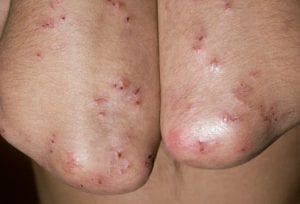HAVE YOU BEEN DIAGNOSED WITH CELIAC DISEASE?
PATIENT EDUCATION GUIDE
Gluten-Free Diet
WHAT IS CELIAC DISEASE
WHAT ARE
THE SYMPTOMS
COMPLICATIONS OF
CELIAC DISEASE
Being diagnosed with celiac disease is the first step to improved health. Since the ONLY treatment at this time is a Gluten-Free diet, let’s start there.
Foods to Include on a Gluten-Free Diet
- Grains and grain based foods
- >Amaranth
- >Arrowroot
- >Buckwheat
- >Cassava
- >Corn
- >Millet
- >Oats (labeled gluten-free)
- >Potato (all varieties)
- >Quinoa
- >Rice (all varieties)
- >Sorghum
- >Tapioca
- >Teff
- >Pasta, breads, cereals, crackers and cookies made from above grains
- Flours from non traditional sources
- >Bean flour: chickpea, lentil, soy
- >Nut flour: almond, chestnut, coconut
- >Seed flour: flax seed
- Dairy
- >Milk
- >Cheese: cottage, feta, blue cheese, cheddar, etc.
- >Yogurt
- >Kefir
- >Ice cream
- >Sour cream
- >Whipped cream
- Animal Protein
- >Meat
- >Eggs
- >Fish/Seafood
- >Poultry
- Vegetable Protein
- >Beans/legumes
- >Hummus
- >Tofu
- >Nut/nut butters
- >Seeds/seed butters
- Fruits and Vegetables
- >All varieties
- Fats and Oils
- >All varieties
- >Butter, Margarine
- >Oils, all varieties
- Sauces, seasonings, sweeteners, and spices – READ ALL LABELS
- >Barbecue Sauce
- >Honey
- >Maple Syrup
- >Mayonnaise
- >Mustard
- >Ketchup
- >Pasta Sauce
- >Pickles, Olives, relish
- >Spices
- >Sugar
- >Sugar substitute
- Alcohol
- >Distilled Spirits
- >Hard Cider
- >Wine
Foods to AVOID on a Gluten-free Diet
- Grains and grain based foods
- >Wheat
- >Kamut, semolina, spelt, triticale
- >Breads, cereals, pasta, cakes, cookies and many snacks
- >Barley
- >Flakes, flour, pearl
- >Malt: flavoring, vinegar, extract, syrup
- >Beer, lager, ale
- >Rye
- >Flour, bread, and flavoring
- >Oats not labeled gluten-free
- Flours from traditional sources
- >Wheat, rye and barley based flours
- Dairy
- >Dairy with added cookie crumbs or granola if not labeled gluten-free
- Animal Protein
- >Imitation crab
- >Marinated, breaded, or coated proteins
- >Caution with deli meats, sausages, salami, hot dogs and prepared meats.
- Vegetable Protein
- >Seitan
- >Caution with tempeh and seasoned beans, nuts and seeds
- >Caution with protein powders
- Fruits and Vegetables
- > Caution with fruits and vegetables prepackaged with sauces
- Fats and Oils
- >Caution with baking spray (Read labels)
- >Butter, Margarine
- >Oils, all varieties
- Sauces, seasonings, sweeteners, and spices – READ ALL LABELS
- >Cake icing
- >Licorice
- >Sprinkles
- >Soy Sauce
- >Gravies, sauces, soups, roux, and thickening agents
- >Spice blends, taco seasoning, marinades,
- >Pancake syrup
- Alcohol
- > Beer unless labeled gluten-free
Dietitians
- Mary K Sharrett, MS, RD, LD, CNSD
- Nutrition Support Service, Nationwide Children’s Hospital, Columbus, Ohio
- Phone: 614-722-3093
- Email: Mary.Sharrett@nationwidechildrens.org
- Web: glutenfreegang.org
- Amy Jones, MS, RD, LD, Chief Clinical Dietitian and Celiac Support Group Facilitator.
- Mary Rutan Hospital. Bellefontaine, Ohio 43311.
- Phone: 937-651-6428.
- Email: ajones@maryrutan.org.
- Web: www.logancountyceliac.org (a CDF Connections support group).
- Nancy Kunkel, RD, LD, CDE. Kettering Medical Center.
- Diabetes and Nutrition Center. Dayton, Ohio.
- Phone: 937-384-6812.
- Email: nancy.kunkel@khnetwork.org.
- Nancy offers nutrition counseling for various conditions but specializes in diabetes and celiac disease.
- Kelli Leingang RD, LD
- Columbus and Dayton, Ohio
- Phone: 937-478-3026
- Email: kellileingang@gmail.com
- Trisha Lyons, RD, LD
- Department of Clinical Nutrition, MetroHealth Medical Center, 2500 MetroHealth Drive, Cleveland, Ohio 44109
- Phone: 216-778-7835
- Trisha’s practice is limited to persons with celiac disease.
- Carol Nartker RD LD CDE
- Samaritan Diabetes Center
- 80 East Woodbury Dr
Dayton , Oh 45415 - Phone: 937 734-6175
- Fax: 937 734-4173
- I have been a registered dietitian for over 35 years and have extensive experience in nutritional counseling. I have been a certified diabetes educator since 1994. I was diagnosed with celiac disease 15 years ago and follow a gluten-free diet.
- Brenda Shapiro, RD, LD
- 26406 Fairmount Blvd., Beachwood, Ohio
- Phone: 440-785-1564
- Email: bshapirordld@scbglobal.net.
- Christine Weese, RD
- University Hospitals-Conneaut Medical Center, 158 West Main Road, Conneaut, Ohio 44030
- Email: Christine.weese@UHhospitals.org
- Chris, who has celiac disease, has facilitated the Gluten-Free Gathering Support Group for 8 years.
*List courtesy of Tricia Thompson | triciathompson@glutenfreedietitian.com
What is celiac disease
It is an autoimmune disorder that stimulates T cells (white blood cells essential for healthy immunity) to inflame the mucosa or lining of the small intestine and destroys the villi, preventing the absorption of nutrients from food into the bloodstream. We are not born with CD, but it occurs in people who are genetically predisposed and can be triggered by a viral or bacterial infection, surgery, mental stress, pregnancy, or the eating the protein gluten present in the grains of wheat, barley and rye. There are about 3,000,000 people with CD in the United States, and it is found in 1% of the population worldwide.
What are the Symptoms of Celiac Disease?
Most people with CD have one or more symptoms, however, some have no symptoms at all. Children usually have different symptoms than adults. Some of the usual complaints of adults are:
- Bloating, gas
- abdominal pain
- diarrhea
- constipation
- anemia
- bone or joint pain
- depression anxiety
- dermatitis herpetiformis
- headaches
- infertility
- missed menstrual periods
- canker sores
- seizures
- tingling numbness in hands and feet
- tiredness

Dermatitis herpetiformis
An itchy, blistering skin rash that usually appears on the elbows, knees, buttocks, back or scalp. The rash appears in about 10 percent of people with CD. The rash can affect people of all ages but is most likely to appear for the first time between the ages of 30-40.
Complications of Celiac Disease
Celiac Disease is a multi-system disorder that results in the body being unable to absorb nutrients due to the loss of absorption in the small intestine. The protein in the grains of wheat, barley and rye actually can pass through the walls of the small intestine which creates the immune response. The body then reacts to create some of the following complications:
- Anemia – unable to absorb iron so that not enough blood cells are able to carry oxygen, creating tiredness and more severe disease.
- Calcium Malabsorption – When the body cannot absorb calcium, the bones become porous and prone to osteopenia and then osteoporosis. This can result in fractures and/ or dental enamel deficiencies.
- Cancer – One of the most immediate concerns of all persons with CD is their increased chances of acquiring one of three different types of cancer: non Hodgkin’s lymphoma, esophageal cancer, and adenocarcinoma of the small intestine. These cancers may be caused by the constant irritation and chronic inflammation of the small intestine’s mucosa or lining.
- Depression – According to the literature, depression is common among people with CD. This frequently subsides with the gluten-free diet. Learning to live with the disease is a challenge to overcome.
- Infertility and Pregnancy – When a woman is having reproductive problems, such as difficulty conceiving a child, carrying a pregnancy to term, or experiencing menopausal upheavals, she should ask to be evaluated for CD. Women with undiagnosed CD have a high rate of miscarriage. The research suggests that 10 percent of unexplained fertility cases are due to CD. Maintaining a gluten-free diet will usually correct these problems.
- Lactose Intolerance – It is not unusual in those newly diagnosed with CD to have lactose intolerance, symptoms include: severe bloating, gas and abdominal pain. Often, these symptoms resolve on a gluten-free diet.
- Menopause – A woman with undiagnosed CD may have increased difficulty during menopause as she may have both CD symptoms and menopausal symptoms. The gluten-free diet can help to balance some of the body’s mechanisms while hormone levels are changing.
- Neurological Symptoms – The research suggests that between 10 and 51 percent of CD patients exhibit neurological symptoms as opposed to 19 percent of the general population. Beyond Celiac has published a recent article that there were identified brain changes in CD patients not seen in other patients. Some of the neurological symptoms can be: ataxia (disturbance of walking or balance), attention deficit disorder, neuropathy, seizure disorders, depression/anxiety, neuropathy, and seizure disorders.
- Other suspected conditions related to CD include: liver disorders, Addison’s Disease, autism, Type I diabetes (up to 15%), microscopic collagenous colitis, fibromyalgia, aphthous ulcers, joint pain, Down syndrome (20% have CD), dysrhythmia (abnormal heart rate).
References utilized for the above information:
- Mary Kay Sharrett MS, RD, LD, CNSC
- Celiac Disease. Center at Columbia University, The Ultimate Guide to Gluten-Free Living , 202 edition.
- Celiac Disease a guide to living with Gluten Intolerance, Authored by Sylvia Llewelyn Bower RN; Mary Kay Sharrett MS, RD, LD, CNSD; Steve Plogstedt Pharm D. Demos Med Publishing, NY, NY 2014.
- National Institute of Health; National Institute of Diabetes and Digestive and Kidney Diseases; 2/26/20
